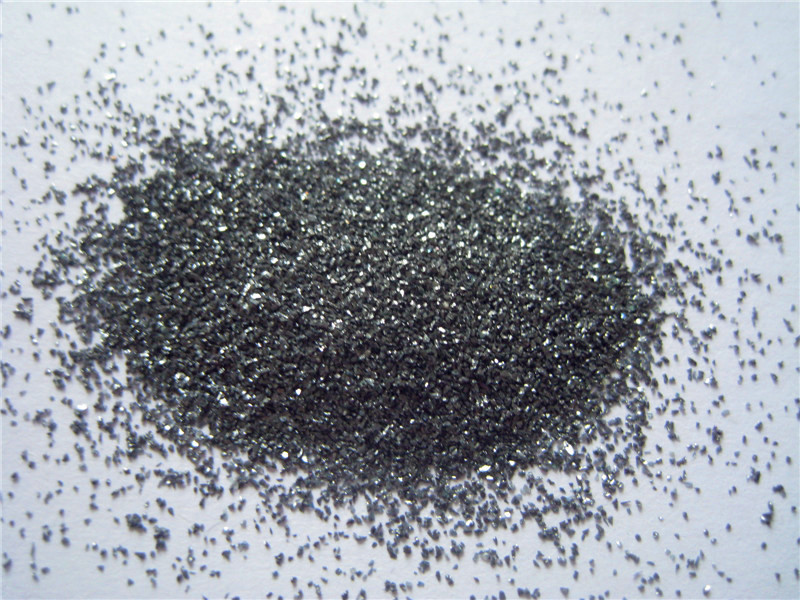What is silicon carbide and its applications.
Silicon Carbide is produced in electrical internal resistance furnaces from high purity silica sands and petroleum coke(adding salt when produce green silicon carbide).
Black silicon carbide

Name :Silicon Carbide (Black/Green)
CAS Number:409-21-2
EINECS Number:206-991-8
Molecular Formula:SiC
Specific Gravity:3.2g/cm3
Mohs Hardness:9.15-9.5
Color:black/Green
Molecular Weight:40.0962
Applied range
Silicon carbide mainly used in four applied fields:Functional ceramics, advanced refractory materials, abrasives and metallurgical raw materials. Silicon carbide coarse materials are already available in large quantities, but cannot be considered a high-tech product. The application of nano-scale silicon carbide powder with extremely high technical content is unlikely to form economies of scale in a short period of time.
1,As abrasive, it can be used to make grinding tools, such as grinding wheels, oilstones, grinding heads, and sand tiles.
2,Used as metallurgical deoxidizer and high temperature resistant material
3.High-purity single crystals can be used to manufacture semiconductors and silicon carbide fibers.
Main applications:Used for wire cutting of 3-12 inch single crystal silicon, polycrystalline silicon, potassium arsenide, quartz crystal, etc. Engineering processing materials for solar photovoltaic industry, semiconductor industry, and piezoelectric crystal industry.
Used in semiconductors, lightning rods, circuit components, high temperature applications, UV detectors, structural materials, astronomy, disc brakes, clutches, diesel particulate filters, filament pyrometers, ceramic films, cutting tools, heating elements, nuclear fuel, jewelry, steel, protective gear, catalyst carriers and other fields.
Abrasive and abrasive tools
It is mainly used for grinding and polishing of grinding wheels, sandpaper, sand belts, oilstones, grinding blocks, grinding heads, grinding pastes, and single crystal silicon, polycrystalline silicon in photovoltaic products and piezoelectric crystals in the electronics industry.
Chemical
It can be used as a deoxidizer for steelmaking and a modifier for cast iron structure, and can be used as a raw material for manufacturing silicon tetrachloride. It is the main raw material for the silicone resin industry. Silicon carbide deoxidizer is a new type of strong composite deoxidizer, which replaces the traditional silicon powder and carbon powder for deoxidation. Compared with the original process, its physical and chemical properties are more stable, and the deoxidation effect is good. It shortens the deoxidation time, saves energy, improves steelmaking efficiency, improves steel quality, reduces the consumption of raw and auxiliary materials, reduces environmental pollution, improves working conditions, and improves the comprehensive economic benefits of electric furnaces. It has important value.
Wear-resistance
Silicon carbide has the characteristics of corrosion resistance, high temperature resistance, high strength, good thermal conductivity, and impact resistance. On the one hand, silicon carbide can be used for various smelting furnace linings, high-temperature furnace components, silicon carbide plates, linings, supports, saggers, silicon carbide crucibles, etc.
On the other hand, it can be used for high-temperature indirect heating materials in the non-ferrous metal smelting industry, such as vertical tank distillation furnaces, distillation furnace trays, aluminum electrolytic cells, copper melting furnace linings, arc plates for zinc powder furnaces, thermocouple protection tubes, etc.; used to make advanced silicon carbide ceramic materials such as wear-resistant, corrosion-resistant, and high-temperature resistant; it can also be used to make rocket nozzles, gas turbine blades, etc. In addition, silicon carbide is also one of the ideal materials for solar water heaters on highways and aviation runways.
Non-ferrous metals
Silicon carbide is used as a high-temperature indirect heating material due to its high temperature resistance, high strength, good thermal conductivity and impact resistance, such as hard pot distillation furnaces, distillation furnace trays, aluminum electrolytic cells, copper melting furnace linings, arc plates for zinc powder furnaces, thermocouple protection tubes, etc.
Steel
Silicon carbide is used for the lining of large blast furnaces due to its corrosion resistance, thermal shock resistance, wear resistance and good thermal conductivity, thereby increasing its service life.
Metallurgical Ore Dressing
Silicon carbide is second only to diamond in hardness and has strong wear resistance. It is an ideal material for wear-resistant pipes, impellers, pump chambers, cyclones, and hopper linings. Its wear resistance is 5-20 times that of cast iron and rubber. It is also one of the ideal materials for aviation runways.
Building materials ceramic grinding wheel industry
Taking advantage of its high thermal conductivity, thermal radiation and high thermal strength, thin-plate kiln furniture is manufactured, which not only reduces the capacity of the kiln furniture, but also improves the kiln capacity and product quality, shortens the production cycle, and is an ideal indirect material for ceramic glaze baking and sintering.
Energy saving
By using good thermal conductivity and thermal stability, it can be used as a heat exchanger, reducing fuel consumption by 20%, saving fuel by 35%, and increasing productivity by 20-30%. Especially for the inner part of the discharge and conveying pipeline used in the mine dressing plant, its wear resistance is 6-7 times that of ordinary wear-resistant materials.

